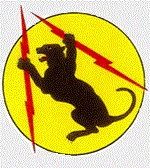Hobby Master HA8410 USAAF Republic P-47D Thunderbolt Fighter - 84th Fighter Squadron "Black Panthers", 78th Fighter Group, England, Autumn 1944 (1:48 Scale)
"Why should we have a navy at all? There are no enemies for it to fight except apparently the Army Air Force."
- General Carl Spaatz, Commander of the US 8th Army Air Force, after WWII
 Nicknamed the "Jug" for its bulky shape, the Republic P-47 Thunderbolt was considered a monster of a machine. Despite its size, the Thunderbolt proved to be a fast and maneuverable warbird able to hold its own in combat. In fact, when Allied pilots climbed aboard a P-47, they knew the were in control of a fighting machine with enormous power. More importantly, they knew that if their aircraft was hit but gunfire, they had an excellent chance of making it home.
Nicknamed the "Jug" for its bulky shape, the Republic P-47 Thunderbolt was considered a monster of a machine. Despite its size, the Thunderbolt proved to be a fast and maneuverable warbird able to hold its own in combat. In fact, when Allied pilots climbed aboard a P-47, they knew the were in control of a fighting machine with enormous power. More importantly, they knew that if their aircraft was hit but gunfire, they had an excellent chance of making it home.
Refinements to the Thunderbolt continued throughout its career, leading to the P-47D, which was the most produced version with 12,558 built. The "D" model actually consisted of a series of evolving production blocks, the last of which were visibly different from the first.
The first P-47Ds were actually the same as P-47Cs. Republic could not produce Thunderbolts fast enough at its Farmingdale plant on Long Island, so a new plant was built at Evansville, Indiana. The Evansville plant first built a total of 110 P-47D-1-RAs, which were completely identical to P-47C-2s. Farmingdale aircraft were identified by the -RE suffix after the block number, while Evansville aircraft were given the -RA suffix.
The P-47D-1 through P-47D-6, the P-47D-10, and the P-47D-11 successively incorporated changes such as the addition of more engine cooling flaps around the back of the cowl to reduce the engine overheating problems that had been seen in the field. Engines and engine subsystems saw refinement, (the P-47D-10 introduced the R-2800-63, replacing the R-2800-21 seen in previous P-47s) as did the fuel, oil and hydraulic systems. Additional armor protection was also added for the pilot.
The P-47D-15 was produced in response to requests by combat units for increased range. "Wet" (equipped with fuel plumbing) underwing pylons were introduced to allow a bomb or drop tank pressurized by vented exhaust air to be carried under each wing, in addition to the belly tank.
Pictured here is a 1:48 scale replica of a P-47D Thunderbolt fighter that was attached to the 84th Fighter Squadron "Black Panthers", 78th Fighter Group, then deployed to England during the autumn of 1944.
Sold Out!
Dimensions:
Wingspan: 10-inches
Length: 8-3/4-inches
Release Date: August 2015
 Historical Account: "Eagles Nest" - The 84th Fighter Squadron was activated in 1942, as the 84th Pursuit Squadron (Interceptor). Soon after its activation the US Army transferred the squadron to England where it lost a majority of its pilots and planes to the American war effort in North Africa. During the war the 84th flew missions ranging from bomber escort, ground attack, counter-air, and close air support.
Historical Account: "Eagles Nest" - The 84th Fighter Squadron was activated in 1942, as the 84th Pursuit Squadron (Interceptor). Soon after its activation the US Army transferred the squadron to England where it lost a majority of its pilots and planes to the American war effort in North Africa. During the war the 84th flew missions ranging from bomber escort, ground attack, counter-air, and close air support.
In April 1943, the unit was involved in its first combat mission in North Africa. In June 1944, the 84th supported the Allied landings at Normandy and directly contributed to the breakthrough at Saint-Lo in July 1944. In September 1944, the squadron contributed to the Allied victory in the Arnhem-Nijmegen airborne landings; notably, they suppressed numerous ground positions during the airborne assault and were credited with saving scores of American and British troop transports. For this action the 84th received the Distinguished Unit Citation.
In December 1944 the 84th began flying the P-51 Mustang. They used their new plane very successfully and on 10 April destroyed 58 aircraft on the ground earning the 84th its second Distinguished Unit Citation. In April 1945 the 84th flew its last combat mission escorting British bombers on their way to Hitler's "Eagles Nest". The squadron completed three years overseas and was credited with 260 German aircraft destroyed


